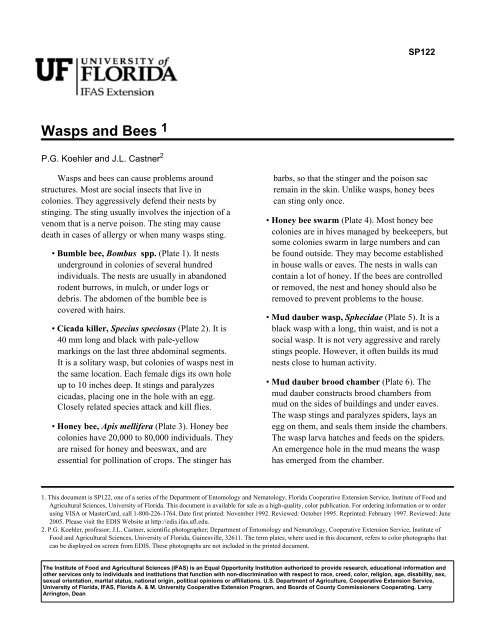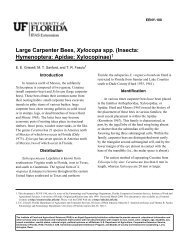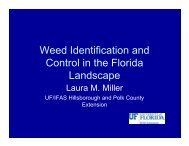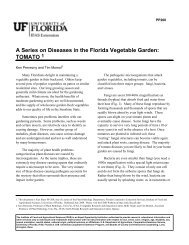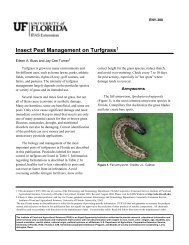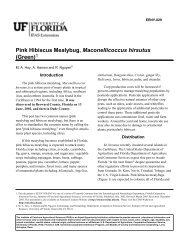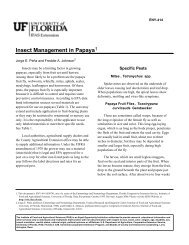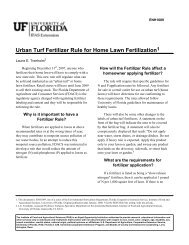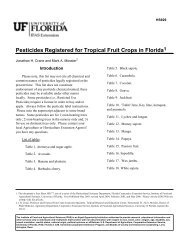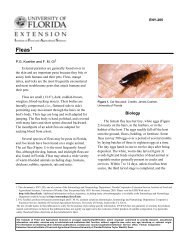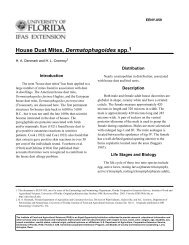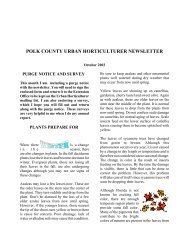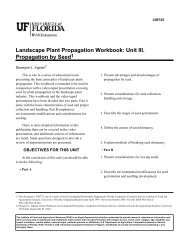Wasps and Bees 1 - Polk County Extension Office - University of ...
Wasps and Bees 1 - Polk County Extension Office - University of ...
Wasps and Bees 1 - Polk County Extension Office - University of ...
You also want an ePaper? Increase the reach of your titles
YUMPU automatically turns print PDFs into web optimized ePapers that Google loves.
SP122<br />
<strong>Wasps</strong> <strong>and</strong> <strong>Bees</strong> 1<br />
P.G. Koehler <strong>and</strong> J.L. Castner 2<br />
<strong>Wasps</strong> <strong>and</strong> bees can cause problems around<br />
structures. Most are social insects that live in<br />
colonies. They aggressively defend their nests by<br />
stinging. The sting usually involves the injection <strong>of</strong> a<br />
venom that is a nerve poison. The sting may cause<br />
death in cases <strong>of</strong> allergy or when many wasps sting.<br />
• Bumble bee, Bombus spp. (Plate 1). It nests<br />
underground in colonies <strong>of</strong> several hundred<br />
individuals. The nests are usually in ab<strong>and</strong>oned<br />
rodent burrows, in mulch, or under logs or<br />
debris. The abdomen <strong>of</strong> the bumble bee is<br />
covered with hairs.<br />
• Cicada killer, Specius speciosus (Plate 2). It is<br />
40 mm long <strong>and</strong> black with pale-yellow<br />
markings on the last three abdominal segments.<br />
It is a solitary wasp, but colonies <strong>of</strong> wasps nest in<br />
the same location. Each female digs its own hole<br />
up to 10 inches deep. It stings <strong>and</strong> paralyzes<br />
cicadas, placing one in the hole with an egg.<br />
Closely related species attack <strong>and</strong> kill flies.<br />
• Honey bee, Apis mellifera (Plate 3). Honey bee<br />
colonies have 20,000 to 80,000 individuals. They<br />
are raised for honey <strong>and</strong> beeswax, <strong>and</strong> are<br />
essential for pollination <strong>of</strong> crops. The stinger has<br />
barbs, so that the stinger <strong>and</strong> the poison sac<br />
remain in the skin. Unlike wasps, honey bees<br />
can sting only once.<br />
• Honey bee swarm (Plate 4). Most honey bee<br />
colonies are in hives managed by beekeepers, but<br />
some colonies swarm in large numbers <strong>and</strong> can<br />
be found outside. They may become established<br />
in house walls or eaves. The nests in walls can<br />
contain a lot <strong>of</strong> honey. If the bees are controlled<br />
or removed, the nest <strong>and</strong> honey should also be<br />
removed to prevent problems to the house.<br />
• Mud dauber wasp, Sphecidae (Plate 5). It is a<br />
black wasp with a long, thin waist, <strong>and</strong> is not a<br />
social wasp. It is not very aggressive <strong>and</strong> rarely<br />
stings people. However, it <strong>of</strong>ten builds its mud<br />
nests close to human activity.<br />
• Mud dauber brood chamber (Plate 6). The<br />
mud dauber constructs brood chambers from<br />
mud on the sides <strong>of</strong> buildings <strong>and</strong> under eaves.<br />
The wasp stings <strong>and</strong> paralyzes spiders, lays an<br />
egg on them, <strong>and</strong> seals them inside the chambers.<br />
The wasp larva hatches <strong>and</strong> feeds on the spiders.<br />
An emergence hole in the mud means the wasp<br />
has emerged from the chamber.<br />
1. This document is SP122, one <strong>of</strong> a series <strong>of</strong> the Department <strong>of</strong> Entomology <strong>and</strong> Nematology, Florida Cooperative <strong>Extension</strong> Service, Institute <strong>of</strong> Food <strong>and</strong><br />
Agricultural Sciences, <strong>University</strong> <strong>of</strong> Florida. This document is available for sale as a high-quality, color publication. For ordering information or to order<br />
using VISA or MasterCard, call 1-800-226-1764. Date first printed: November 1992. Reviewed: October 1995. Reprinted: February 1997. Reviewed: June<br />
2005. Please visit the EDIS Website at http://edis.ifas.ufl.edu.<br />
2. P.G. Koehler, pr<strong>of</strong>essor; J.L. Castner, scientific photographer; Department <strong>of</strong> Entomology <strong>and</strong> Nematology, Cooperative <strong>Extension</strong> Service, Institute <strong>of</strong><br />
Food <strong>and</strong> Agricultural Sciences, <strong>University</strong> <strong>of</strong> Florida, Gainesville, 32611. The term plates, where used in this document, refers to color photographs that<br />
can be displayed on screen from EDIS. These photographs are not included in the printed document.<br />
The Institute <strong>of</strong> Food <strong>and</strong> Agricultural Sciences (IFAS) is an Equal Opportunity Institution authorized to provide research, educational information <strong>and</strong><br />
other services only to individuals <strong>and</strong> institutions that function with non-discrimination with respect to race, creed, color, religion, age, disability, sex,<br />
sexual orientation, marital status, national origin, political opinions or affiliations. U.S. Department <strong>of</strong> Agriculture, Cooperative <strong>Extension</strong> Service,<br />
<strong>University</strong> <strong>of</strong> Florida, IFAS, Florida A. & M. <strong>University</strong> Cooperative <strong>Extension</strong> Program, <strong>and</strong> Boards <strong>of</strong> <strong>County</strong> Commissioners Cooperating. Larry<br />
Arrington, Dean
<strong>Wasps</strong> <strong>and</strong> <strong>Bees</strong> 2<br />
• Paper wasp, Polistes spp. (Plate 7). It is<br />
usually yellow with brown markings or black<br />
with red or yellow markings. These wasps are<br />
aggressive <strong>and</strong> they readily sting. People are<br />
usually stung while trimming shrubbery or<br />
cleaning nests from eaves <strong>of</strong> houses.<br />
• Paper wasp nest (Plate 8). Paper wasp nests<br />
are made <strong>of</strong> a papery material that is shaped like<br />
an inverted umbrella. It usually has a single<br />
comb with up to 250 wasps. Nests are <strong>of</strong>ten built<br />
under eaves or on branches <strong>of</strong> shrubs. The eggs<br />
are laid in a cell. When the larvae hatch, the<br />
wasps feed them. They forage for caterpillars <strong>and</strong><br />
other small insects to feed the larvae.<br />
• Yellowjacket, Vespula spp. (Plate 9). It is<br />
about 12 mm long <strong>and</strong> has alternating yellow <strong>and</strong><br />
black markings on the abdomen. The wasp is<br />
very aggressive in defending itself or the nest.<br />
The stinger is not barbed, so the wasp can sting<br />
repeatedly.<br />
• Yellowjacket nest (Plate 10). The nest can be<br />
quite large for some colonies <strong>of</strong> yellow jackets. It<br />
is made <strong>of</strong> a papery material. Inside, the new<br />
nest has layers <strong>of</strong> combs to raise the brood. Some<br />
nests are aerial, but usually the nests are<br />
subterranean or are both aerial <strong>and</strong> subterranean.<br />
People are usually stung when they step into or<br />
disturb a nest.<br />
Plate 4 .<br />
Plate 5 .<br />
Plate 6 .<br />
Plate 7 .<br />
Plate 8 .<br />
Plate 9 .<br />
Plate 1 .<br />
Plate 10 .<br />
Plate 2 .<br />
Plate 3 .


